I spent the month of May among what biologist E.O. Wilson called, “the little things that run the world,” by which he meant…insects! My visits to four different parks left me astonished at the quantity and diversity of tiny creatures bumping along through the grass, clinging to leaves, dashing about in the sunlight searching for mates and sustenance. I should have known, really. Scientists tells us that’s why so many birds migrate through our state, journeying twice a year across Michigan to savor our insect smorgasbord on their way north or south. But so many! Watch your feet a bit as you travel along the trails. You’ll be amazed at the hubbub just beyond your shoelaces!
So this week I’ll focus on the damselflies and dragonflies, both classified in the order Odonata. Since May began, they’ve been all along the trails, hunting for food and mates.
The damsel flies are positioning themselves in spots of sunlight or cruising just over the tops of plants. The dragonflies are swooping across the fields, snagging prey on the fly, displaying their beauty for likely mates or establishing territories. It’s one big eat, meet, and mate event for both species.
Let’s Start with What “Damsels” and “Dragons” Have in Common…
Damselflies and Dragonflies have a lot in common, actually. Both spend from a few months to as much as five years of their lives underwater as eggs and then nymphs. As residents of bogs, vernal pools and other wetlands, the only goal for nymphs is to eat and grow. Both damselflies and dragonflies are outfitted with fierce jaws that can suddenly lunge forward to grab and gobble prey underwater and then do the same later in their much shorter lives on land. (Luckily, they don’t bite or harm humans.) They grow by molting repeatedly from 6 to 15 times depending on their species. When a nymph begin to emerge, it sticks its head above the water, waiting for its respiratory system to get used to breathing air. Then it climbs onto an aquatic plant, molts one last time and makes the big transformation to a winged creature, leaving the exoskeleton (exuvia) dangling from the plant. It waits again for its wings to expand and the new exoskeleton to harden before taking to the air for the first time.
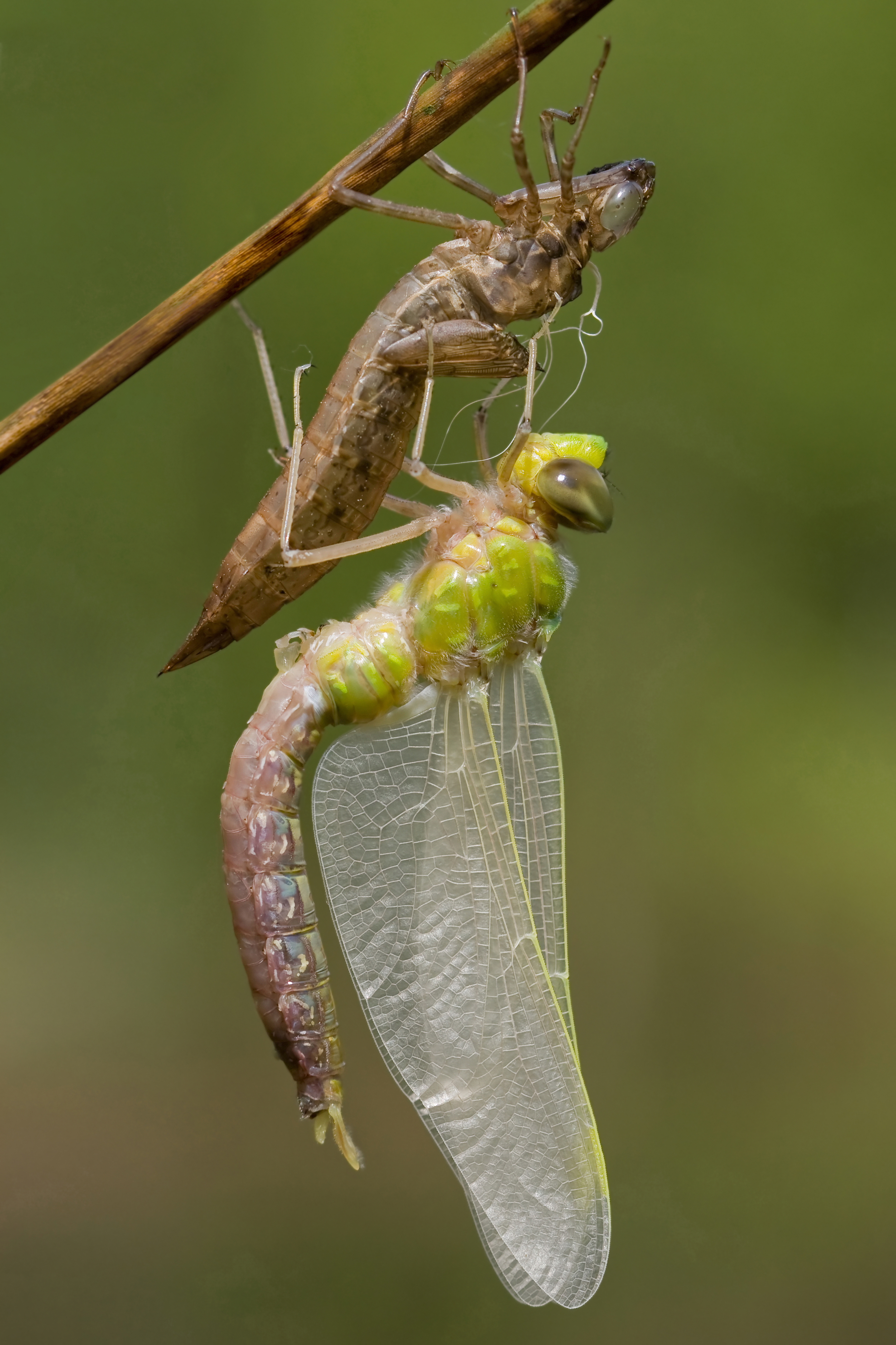
Both damselflies and dragonflies leave their natal wetlands and venture out into nearby fields to hunt, eat and find mates. And when they mate, both “damsels” and “dragons” return to the wetland and twist themselves together into their famous heart-shaped pose, though I’m doubtful there’s much affection involved. Passing on DNA is a serious business!

According to Wikipedia, when ready to mate, the male transfers a packet of sperm from his primary genital opening near the tip of his abdomen to his secondary genitalia near the base. He then holds the female at the back of her head with the claspers at the end of his abdomen. She curls her abdomen down and forward to reach the male’s stored sperm, fertilizing her eggs. Some species stay conjoined while the female lays her eggs. Some males hover over the female or watch her from a short distance, ready to drive off other males. Sometime females lay their eggs alone.
BUT DAMSELS AND DRAGONS ALSO HAVE THEIR DIFFERENCES…
The most obvious differences between damselflies and dragonflies are their size and shape. Damselflies are much smaller than dragonflies and are long and slender. Dragonflies are chunkier at the front with a shape more like a helicopter. (I’m using my photos from other summers in this section to illustrate body differences.)
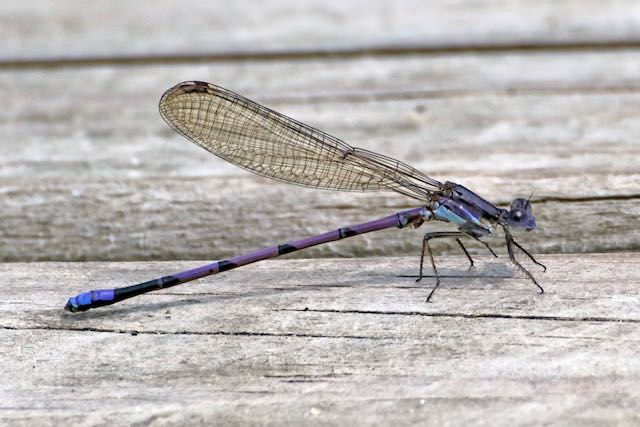
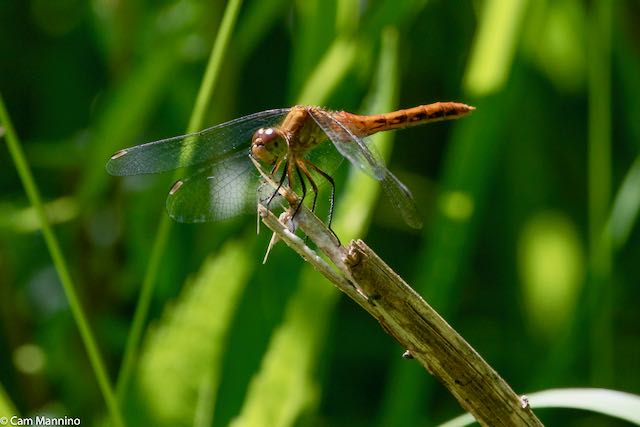
Damselflies eyes are small, brightly colored balls separated in a hammerhead style at either side of their head. But dragonflies have huge eyes that touch each other. Both species, though, have three tiny eyes called ocelli behind their larger multifaceted eyes. The ocelli are simple eyes and help the insect detect light in order to orient themselves for navigation.
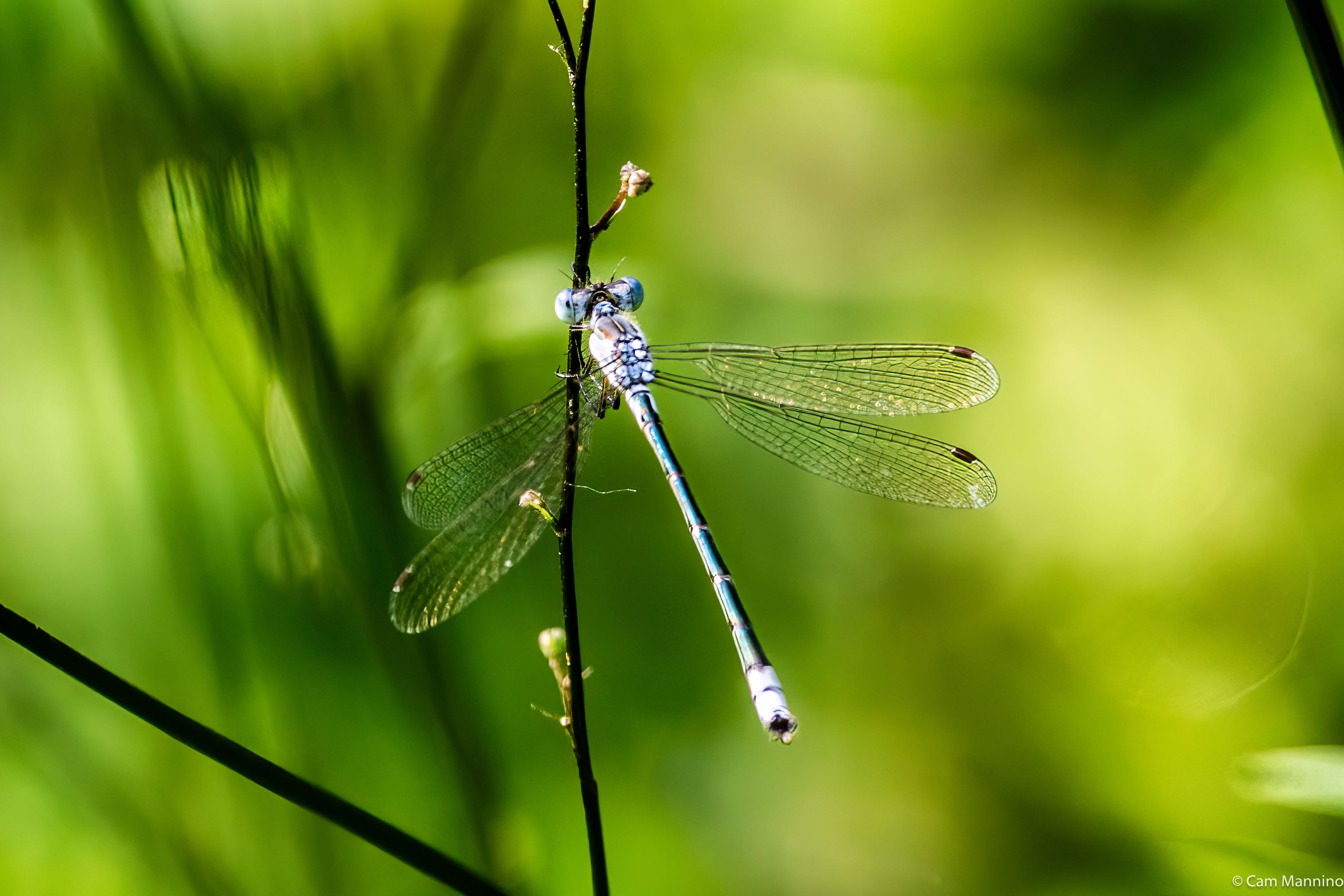

As you can also see above, Damselflies settle with their wings almost straight over their back or at about a 45 degree angle. Dragonflies perch with their wings outstretched, which is a gift to any novice photographer!
But enough about generalities!
This Year’s Earliest Damsels and Dragons!
This May I spent most of my time in four parks: Bear Creek Nature Park, Draper Twin Lake Park, and Charles Ilsley Park and a bird walk at Fox Nature Preserve. But these little creatures will accompany you down the trails in almost any of our parks; they’re always hoping your big feet will scare up an easy meal!
Damselflies
The color of the males of both Damselflies and Dragonflies tend to be more striking and colorful than the females, though you’ll see there are exceptions. Juvenile “damsels”, however, can be very different from either parent, while juvenile “dragons” generally look similar to the female. I was lucky enough to find a “family” of damselflies near the Bear Creek Marsh without knowing it!
I began by checking my useful field guide, Damselflies of Minnesota, Wisconsin and Michigan by Robert Dubois, photos by Mike Reese. I felt sure that I’d identified a male and female Eastern Forktail (Ischnura verticalis), but sent a third photo of a bright orange damselfly to the Facebook page of Odonata of the Eastern United States, a very knowledgeable and helpful group of Odonata fans. These folks know their “odes,” as they call them! I was delighted when it turned out that the third damselfly, the only orange one, was a female juvenile Eastern Forktail, like the two adults. So let me introduce you to the Eastern Forktail family! (Of course I don’t really know if they’re a family, but it’s fun to think so.)

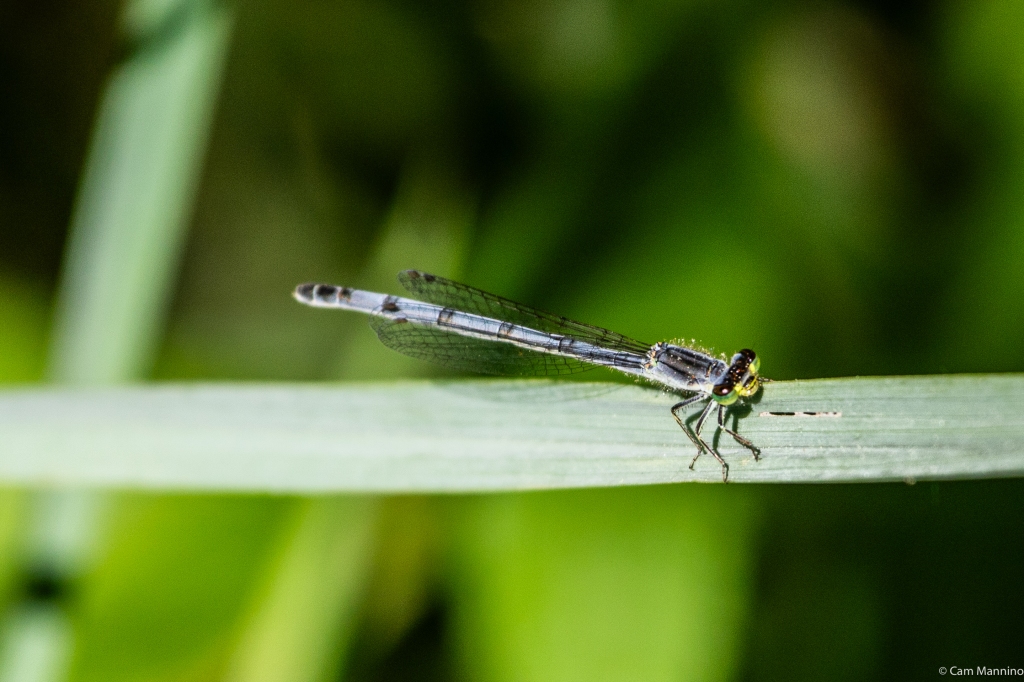
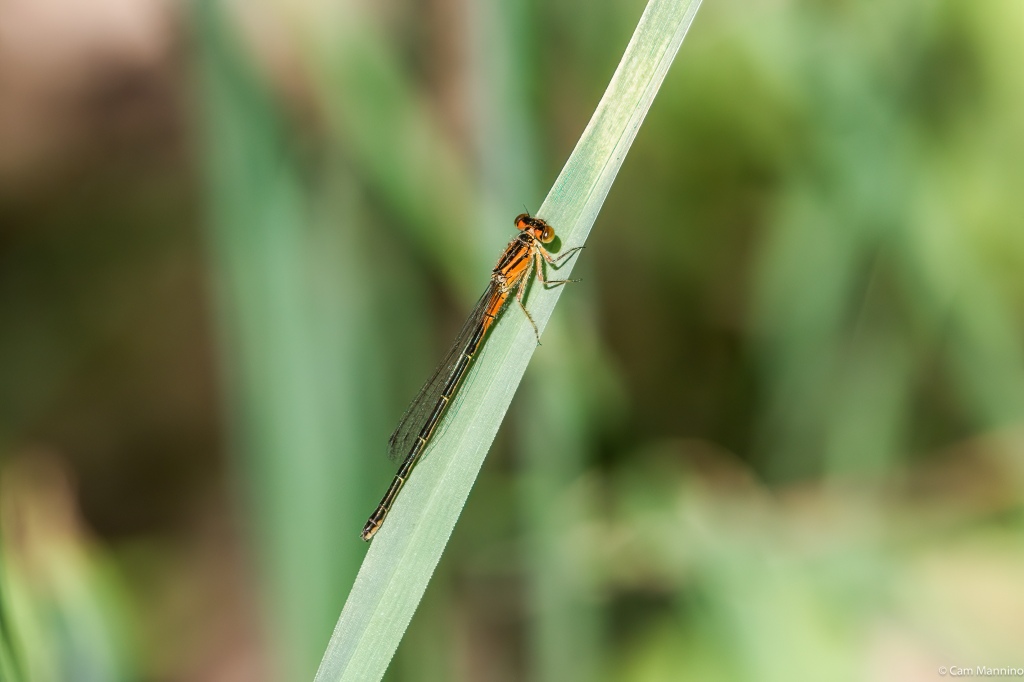
Later, at Bear Creek’s Center Pond, I spotted another female Eastern Forktail just as she approached the stem of a White Water Crowfoot flower (Ranunculus longirostris) and decided to lay her eggs there. Unlike most other damselflies, Forktail males do not guard their females while they lay their eggs; female Eastern Forktails are on their own. She begins by using the sharp ovipositor at the tip of her abdomen to make a slit in the stem. Then she begins inserting her eggs.

The female Eastern Forktail only mates once but stores the male’s sperm to fertilize up to 1000 eggs during her brief aerial life of perhaps two weeks. It must be exhausting! After inserting her eggs in the stem, the female rested with the tip of her abdomen in the water. This move may protect her from males who might try to mate with her or she may simply be resting!

Then she moved slowly off. So odd to see a damselfly move slowly! She settled on a leaf floating among the Duckweed (genus Lemna) and Water Meal (genus Wolffia) in the Center Pond.
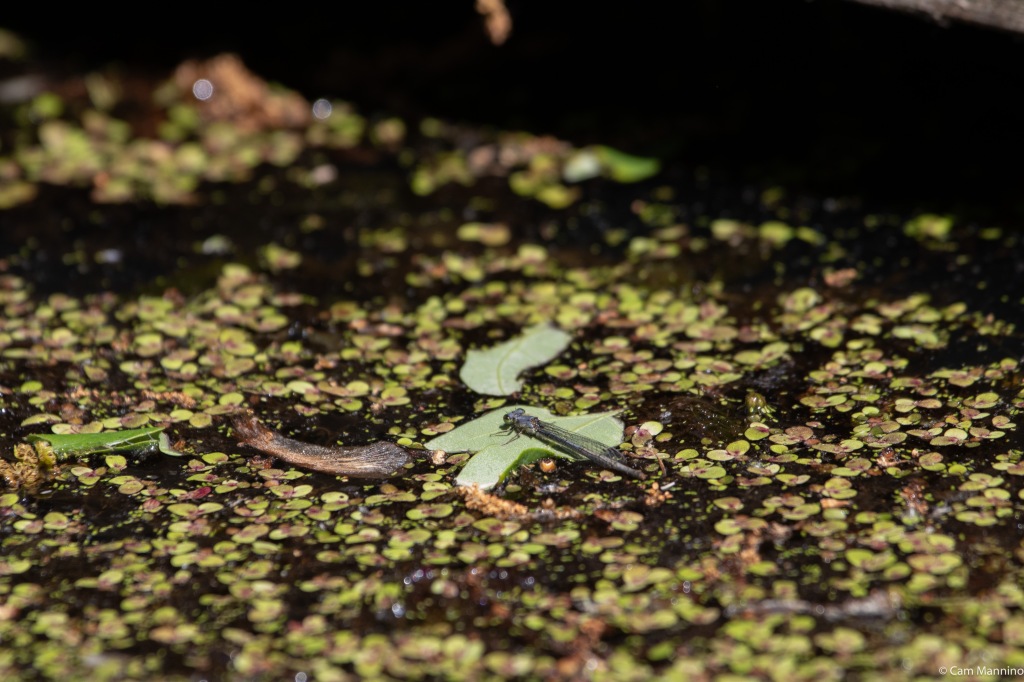
It struck me that perhaps she might have just expelled the last of her many eggs. After all, moving slowly and resting on the surface would have made her very vulnerable to Center Pond predators – the frogs, fish, or birds. But there she was. Quite a little drama, but I didn’t wait for the finale and moved on.
A much larger, 2.25 – 3 inch female Ebony Jewelwing damselfly (Calopteryx maculata) seemed to be displaying in the sunlight at the edge of Bear Creek Marsh. She was standing very tall on her thin legs and she held her dark bronze wings with its white dots high. I assumed she might be ready to mate. So I watched for the more glamorous male to appear, with his solid black wings and brilliant iridescent green body. (See the male above in the heart-shape mating photo.) He never showed up. Too bad because he would do an elaborate display dance for her. But I’m sure I’ll see them again at Bear Creek since their favorite breeding spot is a slow moving, shaded stream like the one that flows out of the Center Pond into the marsh. Ebony Jewelwings should be around until September.

Positioned like a runner about to leap from the blocks, a male Fragile Forktail (Ischnura posita), outfitted in lime green with black racing stripes, must have spotted his prey in the dappled sunlight of the forest near Bear Creek marsh. Damselfly hunting strategy involves sitting motionless on a leaf ready to leap forth at lightning speed to grab any unsuspecting flying insect. This male looks like he’s up to the task doesn’t he?
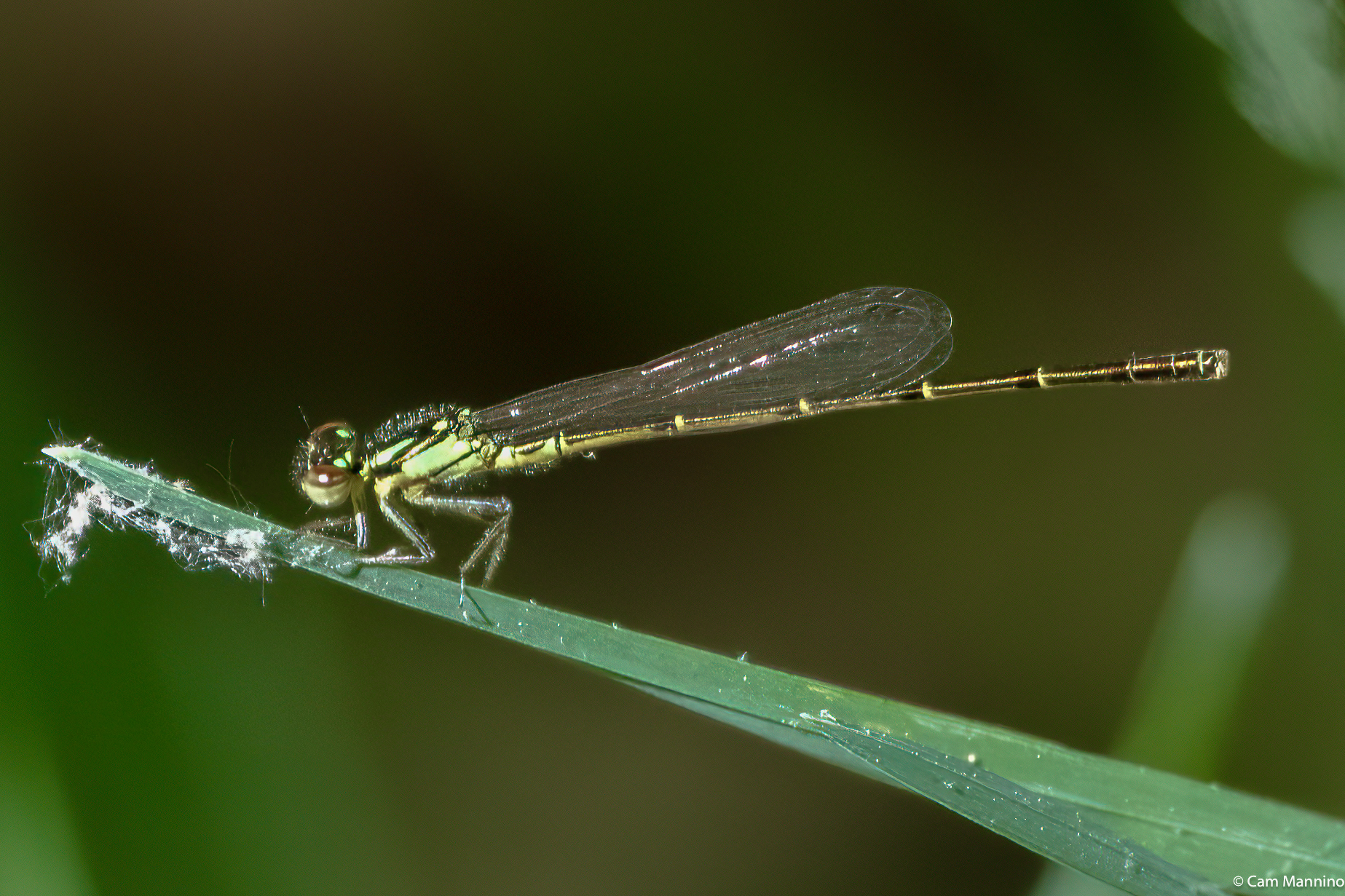
At Draper Twin Lake Park, I came across a drab damselfly who clearly had already aged into the same pruinose state like the female Eastern Forktail that I’d seen earlier. I had little hope of identifying her; the bluish powder had already coated her original colors, turning her gray, much like an aging human, like me, for instance! Again Odonata of the Eastern United States’ Facebook group came to my rescue, somehow identifying her as a female Fragile Forktail damselfly. What a contrast to the flashy green male! But perhaps dimmed colors help these fertile females pass unnoticed among predators. This species of damselflies keeps emerging in multiple generations until September and now I’m interested in finding more of the not-so-fragile Fragile Forktails.

Near Draper Lake marsh, a colorful male Familiar Bluet (Enallagma civile) posed nicely for me. The female of this species first oviposits into a plant stem above the water while in tandem with the male. She then oviposits again beneath the water a second time! Mating and egg laying is a complex undertaking for these little creatures!
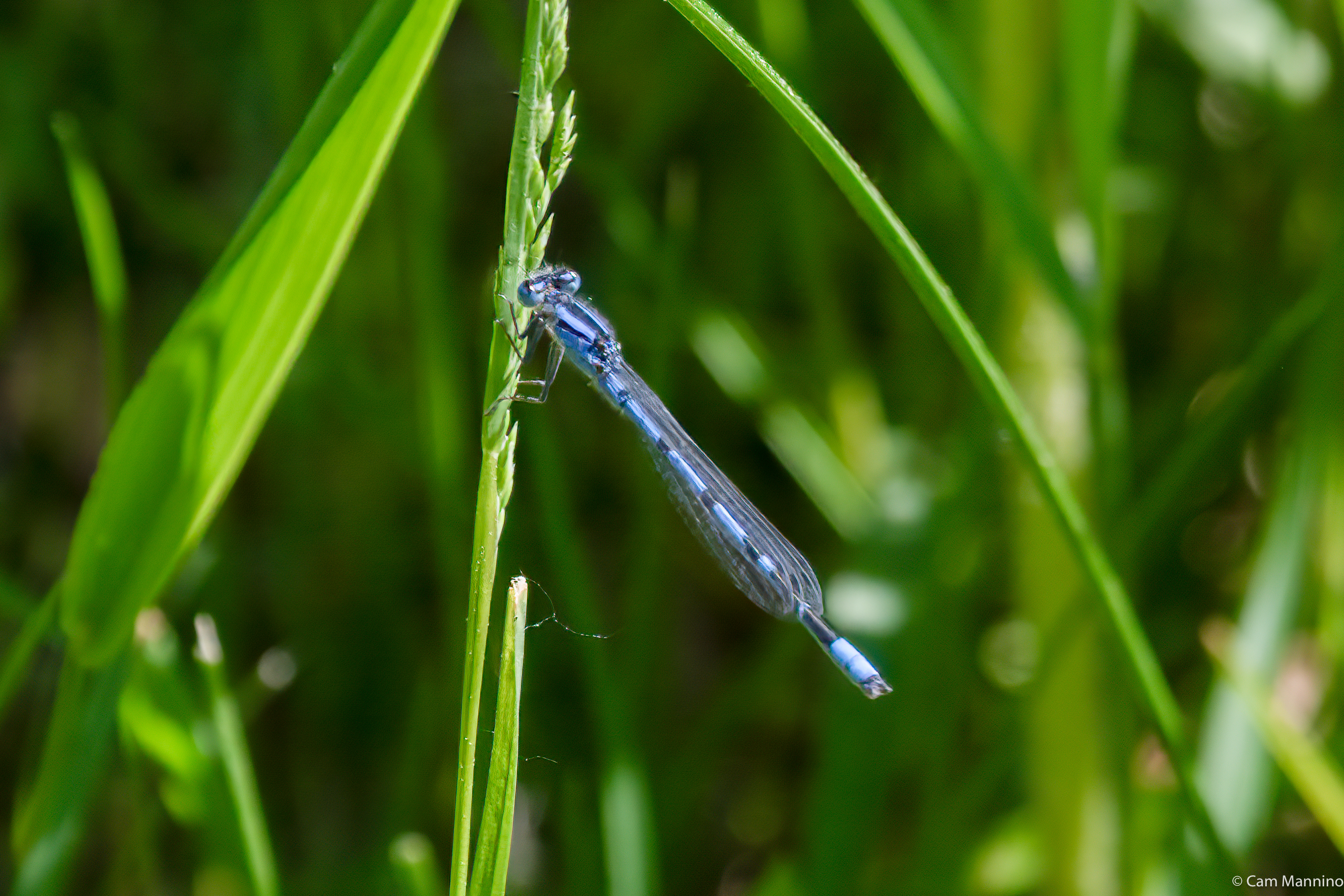
Dragonflies
Only three different dragonflies escorted me down the trails in May. Many larger and more colorful ones will appear as the summer warms. But I got to see two old friend dragonflies and one that I’d never come across before, so no complaints.
One of the earliest dragonflies every year at Bear Creek Nature Park’s Center Pond is the Dot-tailed Whiteface (Leucorrhinia intacta). This year, the male rested for a moment on an oak leaf in the water. He’s a good old boy with his single yellow dotted tail and solid black body framing a white face which always reminds me of Mickey Mouse if I see one head-on.
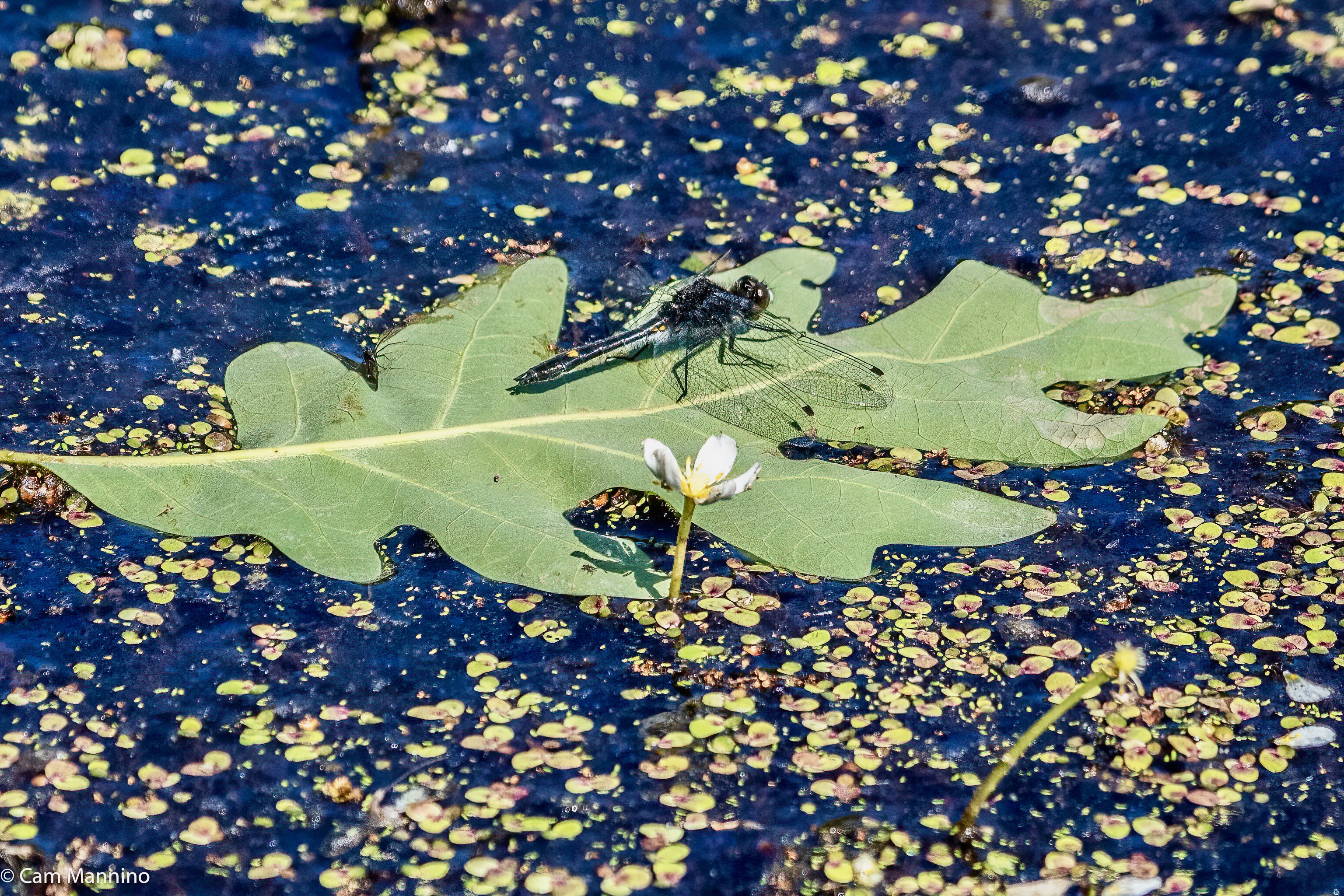
Again, I saw a dragonfly that I didn’t recognize at Draper Twin Lake Park. This time, it turned out to be the female Dot-Tailed Whiteface. She’s quite a bit fancier than her male counterpart. Like their cousins the damselflies, dragonflies leave their wetland nurseries and head upland to mate. This female positioned herself on a stalk in the Draper prairie, a perfect location for attracting a mate. With a series of shiny yellow spots along her abdomen shining in the sunlight and her white face pointing in the opposite direction, I’m confident she’ll be heading back to Draper’s floating marsh to lay eggs before long.

At Fox Nature Preserve, I noticed a third dragonfly, one that I’d never seen before. It’s a female Common Baskettail dragonfly (Epitheca cynosura). She carries her eggs in a bundle on her lower abdomen and then attaches them to a submerged plant. Kurt Mead, author of the field guide, Dragonflies of the North Woods, joked, “You might say all her eggs are in one basket!” In the water, the egg bundle unravels into a 6 inch string. I bet fish and underwater invertebrates are on the hunt for those! The field guide says that in flight, Baskettails are known for “loopy patterns with swift vertical maneuvers. One biologist called them ‘ace stunt flyers.'” Hmmm…wish I’d noticed this one before it landed.

Childhood Curiosity Reawakened
Over the years, we all must have seen small children down on the ground fascinated by little things – bugs, or dandelions, or even just a leaf or twig. It’s just part of babyhood and childhood to be curious, interested in learning about the world. Well, that’s what being a stewardship volunteer and writing this blog has done for me. It’s reawakened my childhood curiosity. Once again, I’m fascinated about the fauna of the exotic mini- jungles down among the grass stems or along the muddy edge of a wetland. Now, despite my love for sweeping landscapes or a sky full of floating heaps of cumulus clouds, the camera reminds me to get down near the ground to look more closely, returning me to a child’s eye view. And behold! Small wonders appear.
Once again I’m delighted by those multi-colored flying sticks called damselflies. Again I stand in awe of the aerobatics of a zigzagging dragonfly in flight. Or find myself imagining what it’s like for their nymphs to crack open their last exoskeleton and suddenly find themselves in brilliantly colored bodies that take them up into a huge airy world filled with sunlight.
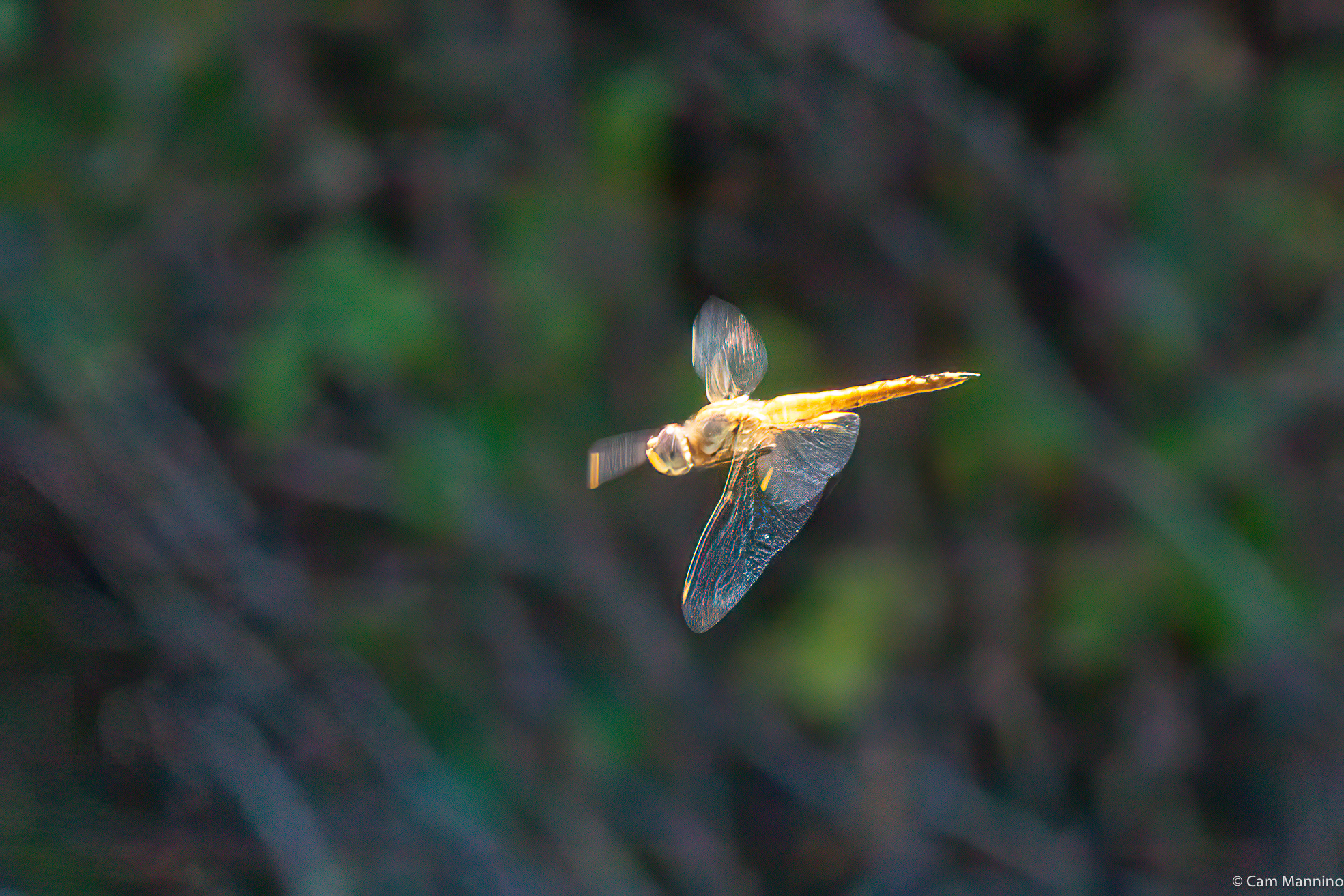
I hope you too are rediscovering the sense of wonder and the curiosity that you felt as a small person. Nature waits for all of us to notice and care about the beauty and complexity it offers up every day. I’m so glad you’re here to share it all with me!

I learned so much again, Cam! What a wonderful piece.
Thank you, Venice. I learned a lot as I researched it, so I’m glad you felt it was interesting and useful. The more I explore nature through doing this blog, the more amazing it seems to me. I’m grateful that you read the blog and I appreciate you letting me know that you enjoyed it.